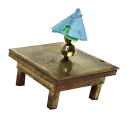Saturday, February 27, 2010
Saturday serial
Friday, February 26, 2010
Brick work
Yes, Minister
Posted by
jim and Mary
at
6:59 AM
![]()
![]()
Labels: cnz venice
Thursday, February 25, 2010
What’s in that crate?
Posted by
jim and Mary
at
6:36 AM
![]()
![]()
Labels: crate, public sculpture
Wednesday, February 24, 2010
Why Pop Art died
Kazakina: That’s pretty hot.
Letter to Lucy
Concrete poetry
Posted by
jim and Mary
at
6:59 AM
![]()
![]()
Labels: city gallery, installation
Tuesday, February 23, 2010
Channel surfing #1
Posted by
jim and Mary
at
11:59 AM
![]()
![]()
Labels: channelling, Look alike
.
Monday, February 22, 2010
Lookalike: vegetable division
Posted by
jim and Mary
at
11:59 AM
![]()
![]()
Labels: Look alike
Andy Warhol
Open Mike
Other posts we've called Open Mike:
Rafting news with Mike Stevenson
Mike Parr on Cockatoo Island
Whoops, Mike Stevenson again
Posted by
jim and Mary
at
6:56 AM
![]()
![]()
Labels: CNZ, cnz venice, parekowhai
Saturday, February 20, 2010
Saturday serial
Friday, February 19, 2010
If I could talk to the animals
Posted by
jim and Mary
at
11:54 AM
![]()
![]()
Labels: animal art, quote
The museum with the hole in the middle
Posted by
jim and Mary
at
6:59 AM
![]()
![]()
Labels: architecture, museums
Thursday, February 18, 2010
Walk with me
Wednesday, February 17, 2010
What they don’t know won’t hurt them
Always on the lookout for foyer art we chanced on a pair of the biggest, and possibly ugliest, paintings by James Rosenquist ever and, to top it off, they were tarted up with the gold frames from hell. Had Rosenquist pulled that sort of stunt in New York he probably would have been laughed out of the piazza, but installed in the Far East the Rosenquist reputation was safe. He wasn’t the only one to trust in the adage out of sight, out of mind. Nearby in the courtyard a Roy Lichtenstein sculpture awkwardly looped around the space wishing it had never left the studio.
Posted by
jim and Mary
at
6:57 AM
![]()
![]()
Labels: artist brands, foyer art
Tuesday, February 16, 2010
Enough
Posted by
jim and Mary
at
1:59 PM
![]()
![]()
Labels: animal art
Hold the bus
Posted by
jim and Mary
at
10:56 AM
![]()
![]()
Labels: Arts Council, CNZ
Waikato Museum rubbishes Mitchell installation
Posted by
jim and Mary
at
6:59 AM
![]()
![]()
Labels: conservation, crate, exhibitions
Monday, February 15, 2010
Goths rule
Posted by
jim and Mary
at
11:51 AM
![]()
![]()
More
Posted by
jim and Mary
at
6:59 AM
![]()
![]()
Labels: exhibitions, painting
Saturday, February 13, 2010
Good taste
Posted by
jim and Mary
at
6:56 AM
![]()
![]()
Labels: art museum
Friday, February 12, 2010
lookalike
Posted by
jim and Mary
at
11:57 AM
![]()
![]()
Labels: Look alike
Reversal of fortune
Posted by
jim and Mary
at
5:59 AM
![]()
![]()
Labels: art museum, upside down art
Thursday, February 11, 2010
Very select
Image: A closed shop
Posted by
jim and Mary
at
6:59 AM
![]()
![]()
Labels: CNZ, cnz venice
Wednesday, February 10, 2010
Mutt and Jeff
The announcement that art dealer Jeffrey Deitch has been appointed to head LA's MOCA has created a huge stir and no more so than in the bunkers of Berlin.
Queue and hay
- Unusual or spectacular visual effects
- Controversy
- High value works from overseas / Masterpieces
- Extreme rarity
Posted by
jim and Mary
at
6:52 AM
![]()
![]()
Labels: blockbuster, city gallery
Tuesday, February 09, 2010
...and you're telling us this because?
Posted by
jim and Mary
at
11:58 AM
![]()
![]()
Labels: art school, massey
.
Illustration: Pippin Barr
Monday, February 08, 2010
Spam
Saturday, February 06, 2010
Friday, February 05, 2010
Art is where you find it: Indian Division
Posted by
jim and Mary
at
6:54 AM
![]()
![]()
Labels: Art is where you find it, conservation
Thursday, February 04, 2010
Advice to new art students
Wednesday, February 03, 2010
Round about now
Posted by
jim and Mary
at
6:56 AM
![]()
![]()
Labels: city gallery, exhibitions
Tuesday, February 02, 2010
Majestic Earth grounded
Posted by
jim and Mary
at
10:36 AM
![]()
![]()
Labels: good art turns bad, public sculpture
C is for Creative
Creative New Zealand has never been that creative in its approach to the arts more often taking a scatter gun rather than focussed approach. The result is their tendency to deliver very generic policy that makes funding decisions end up feeling like patronage. So now is probably as good a time as any to drop the “creative” thing and get back to being an Arts Council with big goals and a sense of where to next, and why.
We hear there are changes afoot to the way CNZ will categorise its various allocations, but don’t expect the performing arts tsunami to recede anytime soon. We plan to keep on asking questions on your behalf and the good news is that under the chairmanship of Alastair Carruthers, there is a push toward more transparency (and so more chance of getting answers) from what has got to be one of New Zealand’s more opaque organisations.






























































